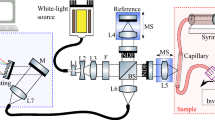Abstract
The utility of optical coherence tomography signal amplitude for the measurement of glucose concentration has been analyzed in tissue phantom and in blood samples from human subjects. The diffusion equation based calculations as well as in-vivo OCT signal measurements confirm a cyclic correlation of signal intensity with glucose concentration and scatterer size.





Similar content being viewed by others
References
N.A. Bazaev, S.V. Selishchev, Noninvasive methods for blood glucose measurement. Biomed. Eng. 41, 40–48 (2007)
C.F. Amaral, M. Brischwein, B. Wolf, Multiparameter techniques for noninvasive measurement of blood glucose. Sensors and Actuators B 140, 12–16 (2009)
B. Rabinovitch, W.F. March, R.L. Adams, Noninvasive glucose monitoring of the aqueous humor of the eye, Part 1, Measurement of very small optical rotations. Diabetes Care 5, 254–258 (1982)
G.L. Cote, M.D. Fox, R.B. Northrop, Noninvasive optical polarimetric glucose sensing using a true phase measurement technique. IEEE Trans. Biomed. Eng. 39, 752–756 (1992)
K.V. Larin, M. Motamedi, M.S. Eledrisi, R.O. Esenaliev, Noninvasive blood glucose monitoring with optical coherence tomography. Diabetes Care 25, 2263–2267 (2002)
R. Poddar, S.R. Sharma, J.T. Andrews, P. Sen, Study of correlation between glucose concentration and reduced scattering coefficients in turbid media using optical coherence tomography. Curr. Sci. 95, 2 (2008)
J.C. Pickup, F. Hussain, N.D. Evans, O.J. Rolinski, D.J.S. Birch, Fluorescence-based glucose sensors. Biosens. Bioelectron. 20, 2555–2565 (2005)
J.R. McNichols, L.G. Cote, Optical glucose sensing in biological fluids: an overview. J. Biomed. Opt. 5, 5–16 (2000)
S.F. Malin, T.L. Ruchiti, T.B. Blank, S.U. Thennadil, S.L. Monfre, Noninvasive prediction of glucose by near infrared diffuse reflectance spectroscopy. Clini. Chem. 45, 1651–1658 (1999)
V. Ashok, A. Nirmalkumar, N. Jeyashanthi, A novel method for blood glucose measurement by noninvasive technique using laser. International Journal of Biological and Life Sciences 6, 3 (2010)
V. V. Sapozhnikova, D. Prough, R. V. Kuranov, Influence of Osmolytes on in vivo Glucose Monitoring using OCT, 231, 1323–1332 (2006)
L. Thrane, H.T. Yura, P.E. Andersen, Analysis of optical coherence tomography systems based on the extended Huygens-Fresnel principle. J. Opt. Soc. Am. A 17, 3 (2000)
A. Ishimaru, Wave propagation and scattering in Random media (Academic, New York, 1978)
Y. Pan, E. Lankenau, J. Welzel, R. Birngruber, R. Engelhardt, Optical coherence-gated imaging of biological tissues. IEEE,Quantum Electronics 2, 4 (1996)
Y. Yang, Z. Zhang, X. Yang, J.H. Yeo, L. Jiang, D. Jiang, Blood cell counting and classification by nonflowing laser light scattering method. J. Biomed. Opt. 9, 995–1001 (2004)
S.N. Thennadill, J.L. Rennert, B.J. Wenzel, K.H. Hazen, T.L. Ruchti, M.B. Block, Construction of glucose concentration in interstitial fluid, and capillary and venous blood during rapid changes in blood glucose levels. Diabetes Technol. Ther. 3, 357–365 (2001)
D.N. Medearis, G.R. Minot, Studies on red blood cell diameter. J Clini Invest 229, 541–556 (1926)
R. Srinivasan, M. Singh, Laser Backscattering and Transillumination Imaging of Human Tissues and Their Equivalent Phantoms. IEEE Trans.on Biomed.Engin 50, 6 (2003)
J.C. Ramella-Roman, S.A. Prahl, S.L. Jacques, Three Monte Carlo Programs of polarized light transport into scattering media: part II, 13, 25 (2005)
H.J.V. Staveren, C.J.M. Moes, J.V. Marle, S.A. Prahl, M.J.C.V. Gemert, Light scattering in Intralipid-10 percent in the wavelength range of 400–1100 nm. Appl. Opt. 30, 31 (1991)
B.F. Kennedy, S. Loitsch, R.A. McLaughlin, L. Scolaro, Paul Rigby, D.D. Sampson, Fibrin phantom for use in optical coherence tomography. J. Biomed. Opt. 15, 1083–1088 (2010)
M.H. Kroll, Evaluating interference caused by Lipemia. Clin. Chem. 15, 11 (2004)
Acknowledgements
The authors thank Professor P. K. Sen for fruitful discussions. The financial support received from UGC, New Delhi and MPCST, Bhopal are acknowledged.
Author information
Authors and Affiliations
Corresponding author
Rights and permissions
About this article
Cite this article
Solanki, J., Sen, P., Andrews, J.T. et al. Blood glucose monitoring in human subjects using optical coherence tomography. J Opt 41, 127–133 (2012). https://doi.org/10.1007/s12596-012-0067-z
Received:
Accepted:
Published:
Issue Date:
DOI: https://doi.org/10.1007/s12596-012-0067-z




